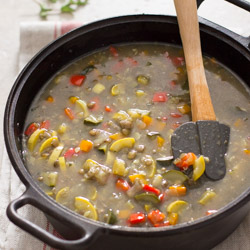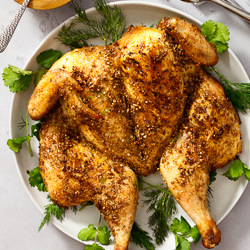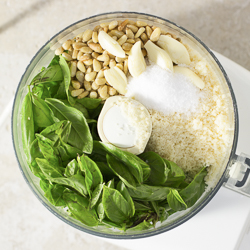Often in cooking classes, I’m asked some version of this same question—how do you make things taste good?
My answer? Salt, acid, fat, and sugar.
Wha…???
Let me elaborate.
You’ve just created a dish. Do you love it? If the answer is yes, then—yay!—your dish is complete.
If not, you have to sleuth out what it needs. Here are the things to consider—the tools in your make-it-taste-good arsenal, if you will—and the order to consider them in.
1. Salt
Salt helps your ingredients sing. Without enough of it, you’re not getting all you can out of them. Another way to say that is, you can’t truly assess what you’ve got until it’s properly salted, because proper salting ensures you’re getting all that’s there.
Try another bite of your dish with three grains of salt sprinkled on top. Is it better or worse? If the answer is better, season the whole dish and do it again—taste a bite as is, taste a bite with three more grains of salt, and if the second bite is better, add salt to the whole dish. And keep doing that until a bite with three more grains of salt is worse.
Notice I didn’t say to keep doing it until it seems like you’ve added enough salt. Or until you can’t believe you’d need more.
Don’t be guessing about this most critical flavor enhancer.
2. Acid, fat, and sugar
If, after salting, you’re still not in love with what you’ve created, the next things to consider are acid, fat, and sugar.
So taste and ask yourself, does it need a tickle of brightness? If so, add acid.
(By “acid” I mean an acidic ingredient—like vinegar, lemon juice, or wine.)
Not sure? A la the salt exercise, try the teeniest tiniest touch of acid on just one bite.
On the other hand, maybe your dish is too tart? If that’s the case, your dish needs softening—typically but not exclusively, fat softens acid in a savory dish and sugar softens acid in a sweet dish. Fat is also a flavor carrier—so sometimes merely adding fat will enhance the overall taste of a dish.
(Fat could be butter, oil, or something fatty/creamy like mayonnaise, milk, or cheese. Sugar could be any sweetener or sweet food.)
About 85% of the time, adjusting salt, acid, fat, and sugar will result in a dish I love. If not, the next things to consider are…
3. Additional flavors
Maybe your dish needs is too one-note and needs a little more going on?
If it has a lot of low, savory, earthy flavors, for example, maybe a tickle of something vernal and delicate would be nice—like chopped fresh parsley sprinkled on top of a hearty beef stew.
If it has a lot of vibrant, bright things going on, maybe it’d be nice to add something savory and earthy—like Kalamata olives in a leek and goat cheese omelet.
You don’t always need opposite or varied flavors to make a dish great—it’s just a place to look.
4. Additional texture
Sometimes adding texture can put a dish over the top—so think about adding crunch to something soft or softness to something crunchy. Creamy blue cheese in a crisp salad, for example, or crunchy nuts on ice cream.
As with flavors, you don’t always need opposite or varied textures to make a dish great—it’s just a place to look.
The most important thing is, if it isn’t love, keep at it. You only have so much time, money, and calories in a day—why settle for anything less?










